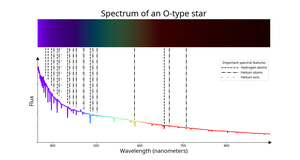Glossary term: O型星
Description: O型星是指光譜類型為 "O "的恆星。天文學家通過光譜中電離氦的吸收線來識別O型星。它們的典型(有效)溫度超過約 30,000 開爾文(K)。與其他恆星相比,人眼中的O型星呈藍白色,除非星際紅化或大氣紅化產生重大影響。O 型星是主要光譜分類中最熱、最藍的恆星。主序上的 O 型星質量最大(約 15 個太陽質量以上),氫燃燒壽命最短,因此大多出現在恆星形成區內和周圍。
Related Terms:
See this term in other languages
Term and definition status: The original definition of this term in English have been approved by a research astronomer and a teacher The translation of this term and its definition is still awaiting approval
This is an automated transliteration of the simplified Chinese translation of this term
The OAE Multilingual Glossary is a project of the IAU Office of Astronomy for Education (OAE) in collaboration with the IAU Office of Astronomy Outreach (OAO). The terms and definitions were chosen, written and reviewed by a collective effort from the OAE, the OAE Centers and Nodes, the OAE National Astronomy Education Coordinators (NAECs) and other volunteers. You can find a full list of credits here. All glossary terms and their definitions are released under a Creative Commons CC BY-4.0 license and should be credited to "IAU OAE".
If you notice a factual or translation error in this glossary term or definition then please get in touch.
Related Diagrams
Spectrum of an O-type star
Credit: IAU OAE/SDSS/Niall Deacon
License: CC-BY-4.0 Creative Commons 姓名標示 4.0 國際 (CC BY 4.0) icons









